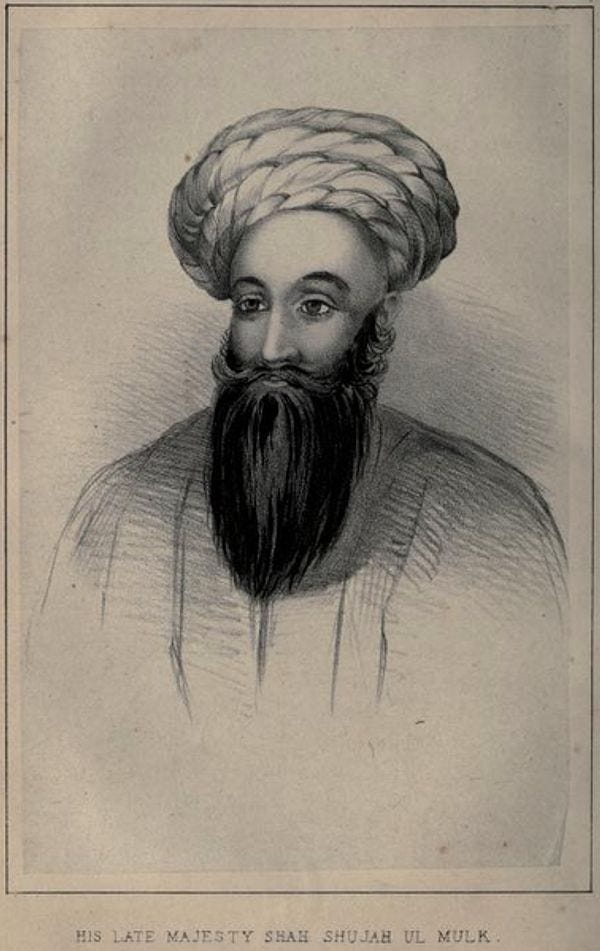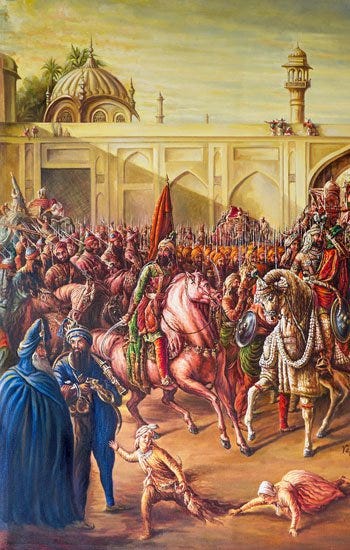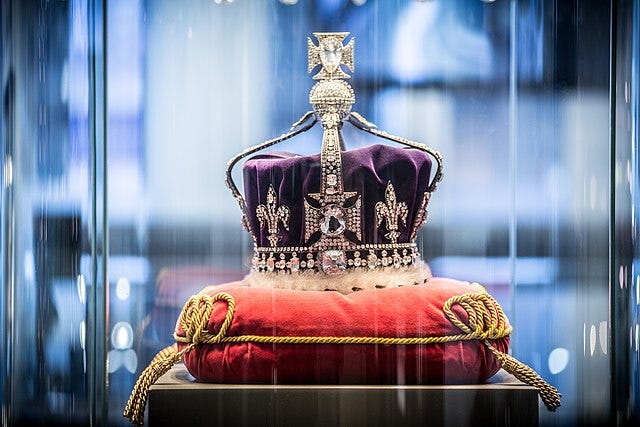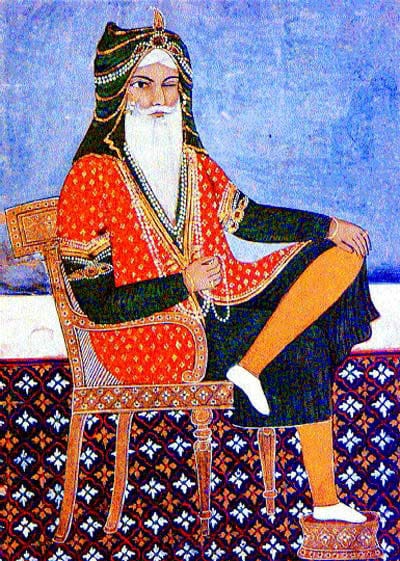The Kohinoor: From Mahabharata to British Crown Jewels - A Journey through Mughals, Persian Invaders, Afghan Kings, and Sikh Sovereigns
The Kohinoor Diamond: A Tale of Afghan Kings, Sikh Rulers, and the Conquest of Kabul, and Retaining Peshawar as a part of the Khalsa Darbar.
The Kohinoor Diamond: A Brief Tale
The Kohinoor, meaning "Mountain of Light" in Persian, is one of the largest cut diamonds in the world. Weighing 105.6 carats after being cut from the original 186 carats by the British, this legendary diamond has a storied and bloody history. It has passed through the hands of Mughal emperors, Persian invaders, Afghan kings, and Sikh rulers, involving the conquest of Kabul in the early 19th century, before becoming a part of the British Crown Jewels.
Maharaja Ranjit Singh and the Kohinoor
A significant chapter in the Kohinoor's history is marked by Maharaja Ranjit Singh, the powerful and respected Sikh ruler. In 1813, the deposed Afghan King Shah Shuja sought refuge in Punjab and offered the Kohinoor to Maharaja Ranjit Singh in exchange for his help in reclaiming the throne of Kabul. Despite the tension and the immense value of the diamond, Maharaja Ranjit Singh honoured his word. He accepted the Kohinoor but also stood true to his promise, through the decades, to assist Shah Shuja. Through a combination of diplomacy and military support, Ranjit Singh played a crucial role in Shah Shuja's eventual, though brief, restoration to power.
Early History of the Kohinoor
The Kohinoor diamond, possibly originating from the Kolar mine in the Deccan, India, is steeped in ancient mythology. Referred to as Syamantaka Mani in Hindu texts, it was believed to be a jewel gifted to Satrajit by the sun god Surya, dating back to the Mahabharata era. However, after centuries of obscurity, the diamond reappeared in 1306 with the Rajas of Malwa.
Over time, the Kohinoor passed through various hands, including the Delhi Sultanate, the Mughal Empire, the Durrani Afghan Empire, and the Sikh Empire. The first verifiable mention comes from Mughal ruler Babur's memoirs in 1526. In 1628, it adorned Shah Jahan's Peacock Throne. The diamond remained with the Mughals until 1739, when Persian invader Nadir Shah took it during his conquest of Delhi.
Shah Shuja and the Kohinoor
At the time of his deposition in 1809, the Kohinoor was in the possession of Shah Shuja Durrani, the ruler of Afghanistan who was forced to live in exile in the Punjab and Sind. In 1809, Shah Shuja attempted to obtain the assistance of Sikh ruler Ranjit Singh to regain his throne by offering him the Kohinoor diamond. After a tense meeting, Shah Shuja reluctantly surrendered the diamond to Ranjit Singh in exchange for his help, as narrated by us before.
The Tripartite Treaty and the Conquest of Kabul
Decades later, in 1838, Shah Shuja gained the support of both the British and Ranjit Singh to reclaim the Afghan throne from the usurper Dost Mohammad Khan. This alliance was formalised through the Tripartite Treaty, signed by Lord Auckland on behalf of the British, who viewed Dost Mohammad as increasingly susceptible to Russian influence. As part of the treaty, Shah Shuja agreed to recognise Ranjit Singh's claim over Peshawar, which was already under the control of the Khalsa Darbar.
In 1839, the British launched an invasion of Afghanistan to reinstate Shah Shuja. Sikh forces assisted the British by attacking Kabul from the north, while the British led the main expedition from the south. The joint British-Sikh forces successfully captured Kabul and placed Shah Shuja back on the throne. The Sikhs held a victory march in Kabul alongside the British, a moment celebrated in Punjabi folklore as the time when the Sikhs hoisted the "Nishan Sahib" over Kabul during the reign of Sher-e-Punjab, Maharaja Ranjit Singh.
Shah Shuja's Tyrannical Rule and Assassination
However, Shah Shuja proved to be a cruel and tyrannical ruler upon regaining power. He engaged in barbaric atrocities against those Afghans he felt had betrayed him, making him extremely unpopular. When the British withdrew from Kabul in 1842, Shah Shuja was assassinated, ironically by his own godson.
Aftermath: Sikhs Retain Peshawar
Although they retreated after the conquest of Kabul, the Sikhs retained control over Peshawar, which they had captured earlier from the Afghans under the leadership of General Hari Singh Nalwa. This followed the fierce Battle of Jamrud, fought in April 1837, in which the veteran Sikh general was mortally wounded, but not before securing control of the strategically located citadel. Peshawar remained in Sikh hands until the end of the Sikh Empire in 1849.
Beginning of the End
The Legacy of Maharaja Ranjit Singh
Maharaja Ranjit Singh, the illustrious and powerful Sikh ruler who secured the Kohinoor from Shah Shuja, passed away in 1839, just before the conquest of Kabul. His death marked the end of an era for the Sikh Empire, a time when the empire's strength and unity were personified by the Maharaja's leadership and vision.
The Fall of the Sikh Empire
In the years that followed, the once-mighty empire faced numerous challenges, culminating in the British annexation of Punjab. In 1849, as part of the Treaty of Lahore, the British East India Company seized the Kohinoor, a symbol of Sikh pride and sovereignty. This loss was deeply felt by the Sikh community, as the diamond represented not just immense wealth but also the legacy of their great Maharaja.
The Kohinoor and British Imperialism
The Kohinoor's journey did not end there. It was later incorporated into the British Crown Jewels, a stark reminder of the colonial subjugation that had befallen India. In 1877, Queen Victoria was proclaimed Empress of India, and the Kohinoor— cut to the present-day size of 105.6 carats from the original 186 carats— became a dazzling but painful emblem of British imperial power.
Contested Ownership and Emotional Legacy
Today, the diamond remains a subject of contention and longing, with countries including India, Pakistan, Iran, and Afghanistan all claiming rightful ownership. For the Sikh community, the Kohinoor is more than a gem; it is a symbol of their rich heritage and the golden era of Maharaja Ranjit Singh's reign. The diamond's tumultuous history evokes a sense of loss and the enduring hope for justice and recognition of their past glories.
If you believe this article would interest someone you know, please feel free to share it anonymously (for us), using any platform that you prefer.









